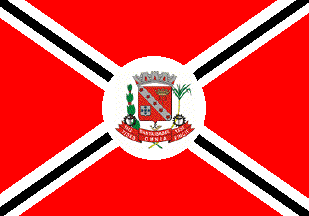 image by
Ivan Sache,
10 February 2013
image by
Ivan Sache,
10 February 2013Based on: http://www.santaisabel.sp.gov.br/Institucional/ConhecaNossaCidade/Bandeira.aspx

Last modified: 2013-02-24 by ian macdonald
Keywords: sao paulo | santa isabel |
Links: FOTW homepage |
search |
disclaimer and copyright |
write us |
mirrors
 image by
Ivan Sache,
10 February 2013
image by
Ivan Sache,
10 February 2013
Based on:
http://www.santaisabel.sp.gov.br/Institucional/ConhecaNossaCidade/Bandeira.aspx
A black saltire, bordered white on a red flag with a white disk bearing the municipal arms in the centre.
Official website at
http://www.santaisabel.sp.gov.br
Dirk Schönberger,
29 January 2013
Santa Isabel emerged as a chapel built to keep a statue of St. Elizabeth of Aragon* in a site used since the 17th century as a resting place by cowboys and travellers heading to the Minas Gerais gold deposits. The first church of the the town, dedicated to the Virgin of the Rosary, was built by salves in 1723. The municipality of Santa Isabel was established on 10 July 1832, seceding from Mogi das Cruzes.
The symbols of Santa Isabel are prescribed in Article 3 of the Municipal Constitution, adopted on 6 December 1990, as "the flag and the coat of arms in official use at the date of promulgation of this Municipal Constitution."
http://www.camarasantaisabel.sp.gov.br/index.php?option=com_docman&Itemid=60 - Municipal Constitution
*St Elizabeth of Aragon (1271-1336) is known as Isabel in Portuguese and Spanish. Queen Consort of Portugal (1282-1325), she retired in a monastery after the death of her husband, King Denis.
The flag was designed by Arcinoé Antônio Peixoto de Faria, in compliance with the Portuguese heraldic tradition. The coat of arms represents the municipal government while the white disk that surrounds it represents the town as the seat of the municipality. The circle is a symbol of eternity, being a geometric figure without either a beginning or a end. The stripes represent the municipal power spreading all over the municipal territory. The quarters represent the rural estates located on the municipal territory.
White is a symbol of peace, friendship, work, prosperity, purity and religious feeling. Black is a symbol of austerity, prudence, knowledge, moderation and strong-mindedness. Red is a symbol of dedication, patriotic love, fertility, audacity, intrepidity, courage and valiance.
The dimensions of the flag are 14 units x 20 units.
http://www.camarasantaisabel.sp.gov.br/index.php?option=com_content&view=article&id=51&Itemid=74 - Website of the Municipal Council
Photo of the flag
h
http://www.citybrazil.com.br/sp/santaisabel/geral_detalhe.php?cat=9
The coat of arms was designed by Major Francisco José Mineiro, with the heraldic advice of Arcinoé Antônio Peixoto de Faria. "A Samnitic shield surmounted by an eight-towered mural crown argent ports gules, gules a bend argent charged with [five] roses of the first surrounded in chief by a Queen's crown surmounting a crown and a pair of scales all or and in base by an escutcheon argent charged with the Portugal 'quinas' azure. A hunting horns or appended to the shield. The shield supported dexter by a branch of coffee fructed and sinister a sugarcane the two proper over two winged caduceus sable and snakes vert orled by gear wheels sable. Beneath the shield a scroll gules inscribed with the municipality's name surrounded by the years '1812' and '1832' all argent. Beneath another scroll gules inscribed with the motto 'FIDES OMNIA VINCIT' in letters argent."
The Samnitic shield, the first style of shield introduced from France to Portugal and inherited by the Brazilian heraldry, evokes the colonizers and main builders of the country. The mural crown is a symbol of municipal emancipation, representing a second-rank town, seat of a "comarca". The bend charged with roses recalls the miracle accomplished by St. Elizabeth, who changed bread into roses**. The Queen's crown and the escutcheon with the Portugal 'quinas' recall that St. Elizabeth was Queen of Portugal. The hunting horn represents cattle breeding. The coffee branch and the sugarcane represent the main crops growing on the generous and fertile soil. The caduceus and the gear wheels represent commerce and industry, respectively. The Latin motto reads "Faith Wins Over All".
Red is a symbol of dedication, patriotic love, audacity, intrepidity, courage and valiance, which are characteristic of the life of St. Elizabeth, the town's patron saint and namesake. Argent is a symbol of peace, friendship, work, prosperity, purity and religious feeling. Or is a symbol of glory, splendour, greatness, wealth, perseverance, zeal and loyalty. Sable is a symbol of austerity, prudence, knowledge, moderation and strong-mindedness. Vert is a symbol of honour, civility, courtesy, abundance and joy.
http://www.camarasantaisabel.sp.gov.br/index.php?option=com_content&view=article&id=52&Itemid=73 - Website of the Municipal Council
**St. Elizabeth used to bring bread to the poor, against the wishes of her husband. Once asked by him to show what she hid under her cloak, she changed the pieces of bread into roses. The very same miracle is attributed to St. Elisabeth of Hungary.
- corrected image
Ivan Sache, 10 February 2013